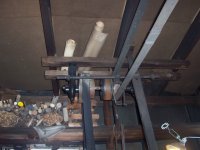dlhiggins1
Plastic
- Joined
- Apr 17, 2010
- Location
- California, USA
hi.....our non-profit learning foundation is building a facility which will house a line shaft machine shop, blacksmith shop and wood working shop....in addition we have some 30-35 vintage tractors and other pieces of farm equipment almost all being brought back to life, plus numerous pieces for the shops....for the line shaft shop we have an early candy-otto camelback press, a peerless hacksaw, an air compressor and a lodge and shipley lathe....we also have a large collection of shaft hangers, etc....all of the buildings needed are in place....what we are looking for is as much information as possible on building the line shaft shop....if there is any reference material in existence that anyone is aware of, please let us know....we are located in a mountain community in california so finding all of the pieces we would like to have is difficult....if you can provide any assistance with regard to that, it would also be helpful...thanks



